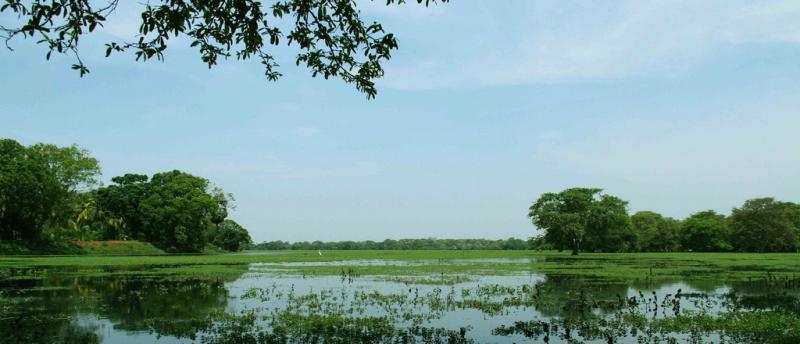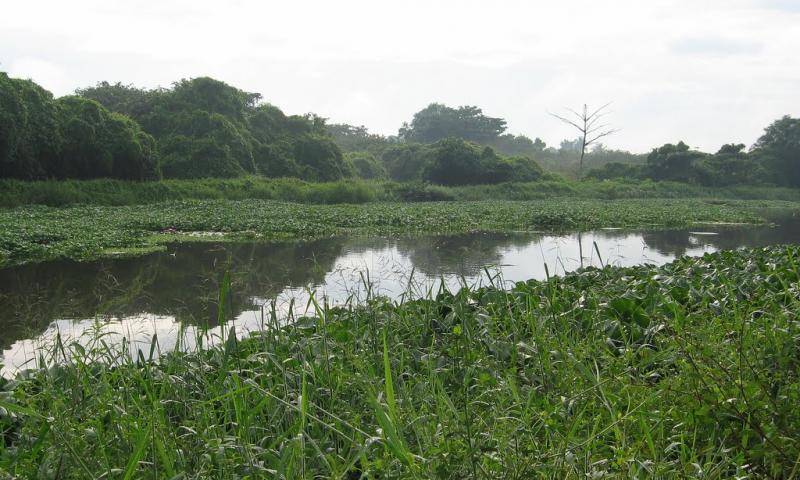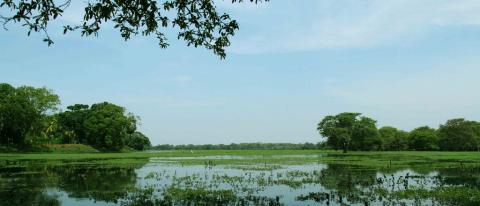Inland Wetlands
The Convention on Wetlands of International Importance especially as Waterfowl Habitat (also called the RAMSAR Convention) defines wetlands as “areas of marsh, fen, peatland or water, whether natural or temporary, with water that is static, flowing, fresh, brackish or salt, including areas of marine water, the depth of which at low tide does not exceed 6 m.”
Wetlands, both natural and man-made, were the centres of Sri Lanka’s ancient hydraulic civilization which thrived in the island for over a thousand years and formed the hub of its cultural, economic and social evolution. Due to the system of land use adopted in ancient times, catchment areas and other important wetlands in the uplands were preserved under forest cover, while the dry zone lowlands were irrigated using water from thousands of rainfed tanks dotted throughout this region. This system of land use served to conserve the biodiversity of natural wetlands. There is also evidence that the conservation of biodiversity in man-made tanks was given consideration in Royal Decrees as early as the twelfth century AD. Many of the wetland sites in Sri Lanka are today being recognized as important, both regionally and globally; and one (Bundala) has been recognized internationally as a Ramsar site.

Anawilundawa Wetland
Both natural and man-made wetlands comprise about 15 per cent of the land area. Rivers and streams, riverine floodplains, small isolated freshwater bodies, freshwater springs, seasonal ponds, and fresh water marshes comprise natural inland wetlands. Coastal wetlands include estuaries and lagoons with associated mangrove swamps, saline marshes, mudflats, and coastal seagrass beds. The man-made wetlands are the rice paddies, irrigation tanks, large reservoirs, canals, and aquaculture ponds. They together make up about two-thirds of the total area of all wetlands.
Sri Lanka’s river system comprising 103 rivers flowing from the central highlands and making up a total collective length of about 4560 km, plays a dominant role in shaping the wetland landscape. At the coast, where they enter the sea, these rivers form lagoons and estuaries. In the dry zone, the rivers and their tributaries supply water to the floodplains and to irrigation reservoirs.
There are extensive marshes and swamps associated with the rivers, which are important in terms of biodiversity. In association with the Mahaweli Ganga and its tributaries alone, there are about 10,000 ha of freshwater riverine marshes which are very rich in biodiversity and are highly productive. Riverine floodplains contain saucer-like depressions (villus) that become inundated with the overflow from rivers during the rainy seasons and contract during drought conditions. The cyclic variation in habitat conditions due to fluctuations in salinity and the depth of water is an important ecological feature that fashions the biodiversity and productivity of villus.
Although Sri Lanka does not have large natural lakes, the total area covered by man-made water bodies exceeds 170,000 ha. There are at present about 10,000 tanks which irrigate over 500,000 ha of land for agriculture. Tanks range in size from 6500 ha down to about one hectare. The vast majority are small; there are less than 100 which exceed 300 ha in size. The tanks were originally constructed many centuries ago. They subsequently fell into disuse and the forest reclaimed the land. Many of the tanks in use today are these old constructions which have been restored. The Jussiaea peruviana, and species of Potamogeton, Chara, Utricularia, Lemna and Najas are found in these tanks. The deeper reservoirs contain floating plants such as Neptunia oleracea, Azolla pinnata, Wolffia arrhiza, Pistia stratiotes and Hydrilla verticillata; fresh water algae, including unicellular and colonial chlorophyta and some filamentous forms; and several species of diatoms. When there is high eutrophication due to pollution, fresh water bodies are dominated by the exotic water weed Eichhornia crassipes and a heavy growth of Cyanophyta (blue-greens). The introduced water weed Salvinia molesta was a serious problem in the past, but has been successfully eradicated from most water bodies due to biological control measures. The shallow village tanks often support a rich phytoplankton among which are Oscillatoria, Microcystis, Hyella and Coelosphaerium. Grasses and sedges occur in the shallow submerged areas, with other herbaceous species such as Monochoria and Jussiaea. At the tank margins are sedges such as Cyperus and Fimbristylis spp., rushes such as Typha spp. And emergent vegetation such as Ipomoea aquatica. Shrubs (e.g. Hibiscus tiliaceus) and small trees occur in the adjacent high ground. River banks support gallery forests with tree species such as Terminalia arjuna Mitragyna parviflora, Madhuca longifolia, Polyalthia longifolia and Diospyros malabarica. Further away from the water, the vegetation merges into the natural forest typical of the area.
Faunistically, inland water bodies are important in terms of zooplankton and invertebrates. Diversity is especially high among the Rotifera. There are also several species of Cladocera, Copepoda, Monogenea and Hirudinea, and numerous freshwater crustaceans. Inland wetlands are also home to over 30 species of fresh water molluscs. Freshwater aquatic systems are among Sri Lanka’s most valuable habitats in terms of macrofauna. The structural diversity of vegetation and the availability of water and open spaces has created an ideal habitat for wildlife, especially the larger grazing mammals such as deer, buffalo and elephant. Foremost among such habitats are the flood plains in the dry zone. Of all wildlife habitats in the country, the Mahaweli flood plains are believed to support the highest animal biomass, especially of large mammals. Wetlands contain numerous species of reptiles, including two species of crocodiles, hard and soft shelled terrapins, the water monitor, and water snakes. The wetlands support almost all of the indigenous amphibian species. They also provide habitats for rare endemic species. Interestingly, the small Waturana swamp forest in the wet zone is the only site in the world where the rare endemic trees Stemenoporus moonii and Mesua stylosa occur and is also the habitat of one of the rarest of endemic fishes, Lepidocephalicthys jonklaasi.

Lepidocephalichthys jonklaasi
Inland wetlands offer food, water and cover to a rich diversity of avifauna, including many migratory species. The rivers and streams that originate in the rain forests of the wet zone constitute the main habitats for indigenous freshwater fish, including almost all the endemic species. The wet patanas in the montane region (typically at Horton Plains) are unique in their characteristic wetland flora, including the patana grasses, reed bamboo, ferns and flowering herbs, as well as the stream fauna, such as the naturalized rainbow trout. The Anuradhapura tanks, in the dry zone, are the home of some species of fish (e.g. Puntius ticto and Labeo porcellus) that are limited to the dry zone.

Bellanwila-Attidiya Sanctuary
Coastal wetlands such as Bundala, the only Ramsar site in Sri Lanka, host a large number of migrant bird species that winter in this country from August to April annually. Freshwater marshes, such as the Bellanwila-Attidiya sanctuary, provide a habitat for over 150 species of birds. Due to its urban location and ease of access, this site is of great value for conservation education, scientific research and recreation. The Kalametiya sanctuary is of special importance because of its avifauna, which number over 150 species including water birds such as pelicans, cormorants, herons, storks, egrets, ibises, migrant ducks and some rare species such as the Black Capped Kingfisher and the Indian Reef Heron.
Many components of wetland biodiversity are currently or potentially of economic value. They carry out ecological functions that contribute, directly or indirectly, to the well being and development of communities. For instance, they serve to prevent or mitigate floods following heavy rain. Coastal wetlands such as mangroves stabilize the shoreline and prevent coastal erosion, and provide important sites for aquaculture. Due to their key role in the cycling of nutrients, wetlands support a high biomass and provide local people with wood, food, pasture and manure. They often serve as sinks for urban wastes and a medium for transportation, and are of high aesthetic, recreational and scientific value.
Most wetlands occur on state lands, but some are either wholly or partly under private ownership (e.g. Walauwawatte-Waturana swamp forest; Bellanwila-Attidiya Sanctuary). Some of the most important wetlands occur within protected areas managed by the Department of Wildlife Conservation. These include wetlands in the Mahaweli flood plains, Maduru Oya, Yala East, Ruhuna, Bundala, Horton Plains and Wilpattu, and in the Kalametiya Sanctuary and the Bellanwila- Attidiya Sanctuary. The Muthurajawela marsh is also under the Department of Wildlife Conservation.

